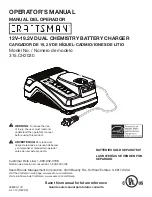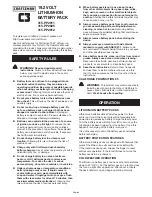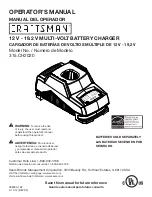
w
ar
nings
7
headline bars
co
ntinu
ation tabs
headline bars
continuation tabs
notes
warnings
headline bars
continuation tabs
notes
warnings
headline bars
Model no. 011-1970-8 Questions? Contact us 1-888-942-6686
6
CHARGE LOCATION
CONNECTING YOUR BATTERY
DC CONNECTION PRECAUTIONS
CONNECTING YOUR BATTERY
Locate charger as far away from battery as
DC cables pemit.
Never place charger directly above battery
being charged; gases from battery will
corrode and damage charger.
Never allow battery acid to drip on charger
when reading electrolyte specific gravity or
filling battery.
Do not operate charger in a closed-in area
or restrict ventiation in any way.
Do not set a battery on top of charger.
Connect and disconnect DC output clips
only after removing AC cord from electric
outlet.
•
•
•
•
•
•
•
•
•
•
Attach clips to battery and chassis as
indicated in the Connecting Your Battery
section.
FOLLOW THESE STEPS WHEN BATTERY IS
INSTALLED IN VEHICLE
WARNING: A SPARK NEAR THE BATTERY MAY
CAUSE A BATTERY EXPLOSION. TO REDUCE
THE RISK OF A SPARK NEAR THE BATTERY:
FOLLOW THESE STEPS WHEN BATTERY IS
OUTSIDE VEHICLE
WARNING: A SPARK NEAR THE BATTERY
MAY CAUSE A BATTERY EXPLOSION. TO
REDUCE THE RISK OF A SPARK NEAR THE
BATTERY:
•
Position AC and DC cords to reduce risk of
damage by hood, door or moving engine
part.
Stay clear of fan blades, belts, pulleys, and
other parts that can cause injury to persons.
Check polarity of battery posts. POSITIVE
(POS, P, +) battery post usually has larger
diameter than NEGATIVE (NEG, N, -) post.
Determine which post of battery is grounded
(connected) to the chassis.
If negative post is grounded to chassis (as in
most vehicles), see step “For
negative-grounded vehicle”. If positive post
is grounded to the chassis, see step “For
positive-grounded vehicle”.
For negative-grounded vehicle, connect
POSITIVE (RED) clip from battery charger to
POSITIVE (POS, P, +) ungrounded post of
battery. Connect NEGATIVE (BLACK) clip to
vehicle chassis or engine block away from
battery. DO NOT connect clip to carburetor,
fuel lines, or sheet-metal body parts.
Connect to a heavy-gauge metal part of the
frame or engine block.
• For positive-grounded vehicle, connect
NEGATIVE (BLACK) clip from battery
charger to NEGATIVE (NEG, N, -) unground-
ed post of battery. Connect POSITIVE (RED)
clip to vehicle chassis or engine block
away from battery. Do not connect clip to
carburetor, fuel lines, or sheet-metal body
parts. Connect to a heavy-gauge metal part
of the frame or engine block.
• When disconnecting charger, turn switches
to off, disconnect AC cord, remove clip
from vehicle chassis, and then remove clip
from battery terminal.
•
Check polarity of battery posts. POSITIVE
(POS, P, +) battery post usually has larger
diameter than NEGATIVE (NEG, N,- ) post.
Attach at least a 24" (61 cm) 6-gauge
(AWG) insulated battery cable to NEGATIVE
(NEG, N, -) battery post.
Connect POSITIVE (RED) charger clip to
POSITIVE (POS, P, +) post of battery.
•
•
•
Position yourself and free end of cable as
far away from battery as possible, then
connect NEGATIVE (BLACK) charger clip to
free end of cable.
Do not face battery when making final
connection.
When disconnecting charger, always do so
in reverse sequence of connecting
procedure and break first connection while
as far away from battery as practical.
A marine (boat) battery must be removed
and charged on shore. To charge it on
board requires equipment specially
designed for marine use.
•
•
•
•
•
•
•
•
headline bars
continuation tabs
notes
warnings
FPO
WARNING!
A SPARK NEAR A BATTERY MAY CAUSE A BATTERY EXPLOSION!
Battery chargers may get hot during operation. DO NOT set charger
on flammable materials like carpeting, upholstery, paper, cardboard,
etc. Charger may damage leather and plastic.
SAFETY
CONNECTING YOUR BATTERY
Be sure area around battery is well
ventilated while battery is being charged.
Clean battery terminals. Be careful to keep
corrosion from coming in contact with
eyes.
Add distilled water in each cell until
battery acid reaches level specified by
battery manufacturer. Do not overfill. For a
battery without removable cell caps, such
as valve-regulated lead-acid batteries,
carefully follow manufacturer’s reacharg-
ing instructions.
Study all battery manufacturer’s specific
precautions while charging and follow
recommended rates of charge.
Determine voltage of battery by referring
to car owner’s manual and make sure that
output voltage selector switch is set at the
correct voltage. If charger has an adjust-
able charge rate, charge battery initially at
lowest rate.

























